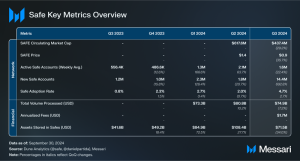Key Insights
- In Q3 2023, Matcha experienced a 7% increase in trades processed and a 2.7% decrease in the daily average rate of failed trades (revert rate). Simultaneously, trading volume and daily average unique traders declined by 32% and 17%, respectively.
- Optimism trades overtook Ethereum trades for total trade share on Matcha in Q3 2023, accounting for 30% of all trades while Ethereum accounted for 18%.
- In addition to multiple upgrades, Matcha increased its token coverage from 11,000 to 4.7 million, grew its supported liquidity sources from 72 to over 100, and expanded trading support to Base.
- Matcha Auto was launched in May. It provides users with quicker transaction execution, gas fee abstraction, and MEV risk mitigation for a fee of 0.15% on trades.
Primer on Matcha
Matcha is a decentralized exchange (DEX) aggregator that was launched in June 2020 by 0x. As a DEX aggregator, Matcha aims to deliver users the best prices on DeFi trades. Using the 0x Swap API, Matcha finds the best-executed price from over 100 onchain (i.e., AMMs) and offchain (i.e., 0x proprietary RFQ) liquidity sources. This approach enhances price efficiency and optimizes gas costs for users, rendering it a more economical choice than direct trading on platforms like Uniswap or Sushiswap.
Other core features of Matcha include:
- Multi-chain Support: Matcha currently supports trading on nine networks, including Ethereum, BNB Smart Chain (BSC), Polygon, Avalanche, Optimism, Fantom, Celo, Arbitrum, and Base.
- Token Coverage and Aggregated Liquidity: Matcha indexes over 4.7 million tokens across 100+ DEX liquidity sources to find users optimized trading prices.
- Embedded Gas: Gas fees are embedded into trades to cover re-submission costs, reducing the concern over failed transactions and removing the need for users to hold native gas tokens.
- MEV Protection: Powered by 0x Swap APIs, Matcha users avoid slippage and MEV attacks. Users on Ethereum and Polygon that use Matcha Auto (powered by Tx Relay API) or manually route trades through RFQ avoid MEV attacks as well.
Key Metrics

Performance Analysis
Volume and Trades
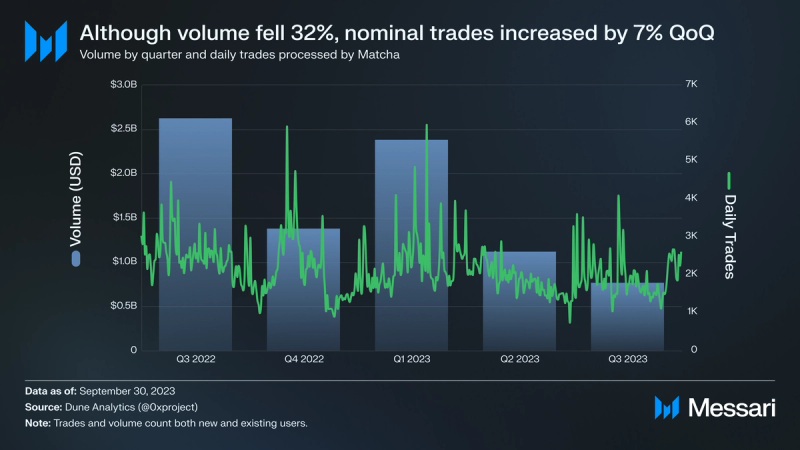
Matcha’s total number of trades increased 7% QoQ. However, quarterly volume dropped below $1 billion to $766 million, hitting its lowest level in a year. This dynamic, combined with the 9% QoQ decline in the value of the crypto market as a whole, suggests that Matcha users are executing smaller trade sizes while Matcha continues to retain usage.
When markets become favorable again, Matcha will be well-positioned to capture higher volume trades, given its features like RFQ routing and Matcha Auto work to mitigate MEV attacks. In Q3, 36% of the volume and 21% of trades were protected from MEV. Even in the current state of the market, a high-volume trader executed a $468,000 trade on Matcha in July.
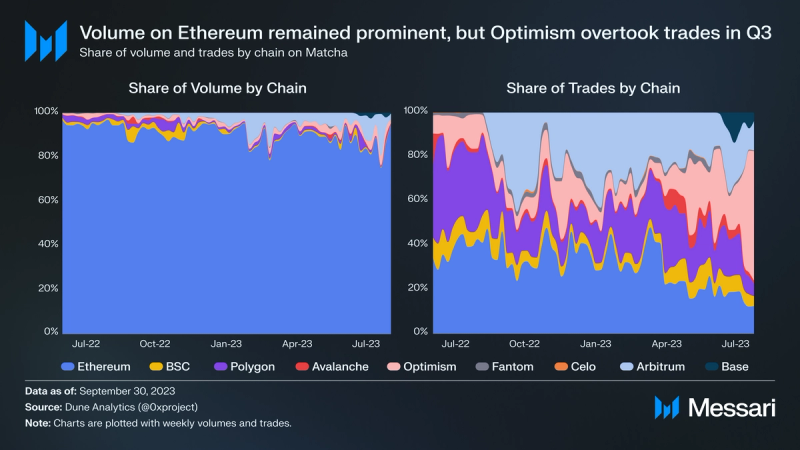
Ethereum continues to account for most of the volume on Matcha, despite decreasing for the second quarter in a row. Throughout Q3, it fell from 90% dominance to 87%. Most of this volume share was accumulated by Optimism (+1.4%), Base (+0.6%), and BNB Smart Chain (+0.4%). Though it picked up less share, Arbitrum still accounted for the second most amount of volume on Matcha at 6.2%.
Regarding trades, volume did not correspond to trading activity. Optimism overtook Ethereum as the top network for trade execution, accounting for 30% of all trades. Arbitrum also overtook Ethereum, accounting for 19% while the volume leader took 18% of trades. However, both still decreased their respective shares QoQ.

ETH (including ETH derivatives) and USD-pegged stablecoins make the most popular trading pair on Matcha. Despite breaking from the downward trend in Q2, the share of the ETH/Stable pair decreased by 11% in Q3, falling from 47% to 36%. This follows a broader trend over the past twelve months, given it accounted for 58% of the volume in Q3 2022. The dominance of stablecoin-to-stablecoin trading (Stable/Stable) followed a reverse trend. Its dominance increased throughout the year, starting at 19% and reaching 30% in Q3 2023. If Ethereum continues to become less dominant in volume and trades on Matcha, the popularity of the Stable/Stable pair should continue to grow, especially on networks with lower gas fees.
Unique Traders
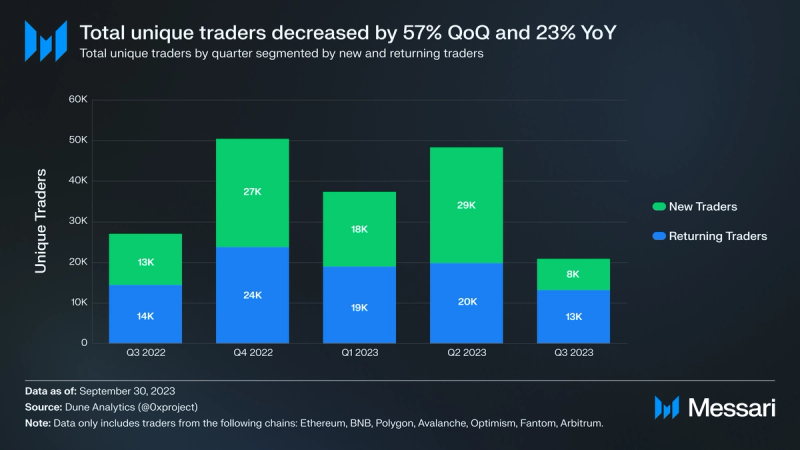
In Q3, Matcha shipped new upgrades that improved user experience and supported more networks, liquidity sources, and token coverage. Regardless, its returning traders decreased by 34%, and its new traders decreased by 72% QoQ. Given Matcha’s new developments, these declines were likely a result of the sustained, depressed market conditions. At a more granular level, daily active unique traders fell by only 17% QoQ. For comparison, 1inch experienced a similar decline in its daily active users, dropping by 16% QoQ.
Revert Rate
Matcha uses the 0x Swap API and 0x Protocol for its backend processes. The 0x Swap API aggregates liquidity across all supply sources (onchain and offchain), helping traders by filing orders with the best prices. This process requires orders to be stored offchain while trade settlement occurs onchain. The 0x Protocol ensures all parts of the trade are satisfied before executing the swap; if not, the trade is reverted. The revert rate is useful for determining the reliability of the protocol.
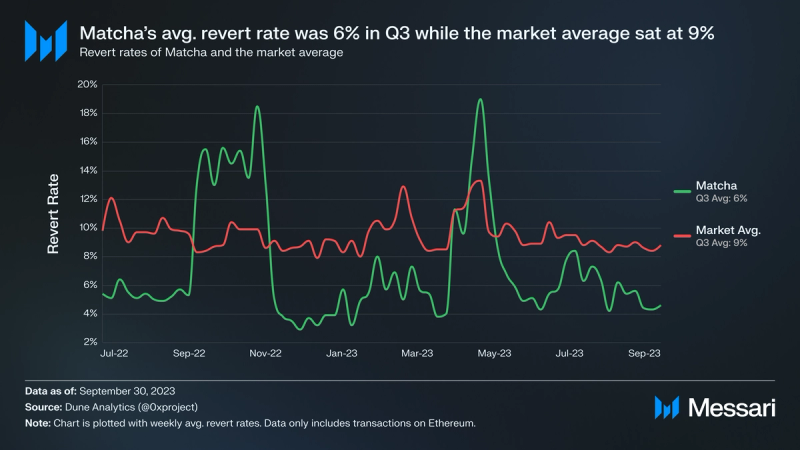
Since Q3 2022, Matcha’s daily average revert rate has fluctuated but largely improved. It hovered around 6% in Q3 2023 for its second-lowest quarterly rate of the year. Meanwhile, the average revert rate across the DEX market was roughly 9%. Matcha’s continued low revert rate is reflective of the robustness of its underlying protocol, 0x, which has been building DeFi infrastructure since launching in 2017.
Qualitative Analysis
Matcha Auto
Matcha Auto is a new transaction mode that was developed using the Tx Relay API. It provides users with faster trade confirmations and fewer failed trades. The new mode was launched in May 2023 and includes the following features:
- Facilitating quicker transaction execution, gas fee abstraction, and MEV risk mitigation for a 0.15% fee on trades. (Standard transaction mode does not charge any fees.)
- Providing access to all 100+ onchain liquidity sources and the 0x RFQ book.
- Abstracting away gas fees, removing the need for users to hold native gas tokens; instead, users pay a fee in the token they’re trading.
- Dynamically adjusts gas fees, increasing the likelihood of a transaction being included in the next block.
- Reduces MEV attacks by routing trades offchain (the Tx Relay API takes a trade’s details and optimizes it for settlement over private channels).
Matcha Upgrades
Matcha underwent a series of new upgrades to the underlying protocol and its interface in Q3.
- Token coverage increased from 11,000 to 4.7 million.
- Supported liquidity sources increased from 72 to over 100.
- Matcha added support for Base in August 2023.
- When users search for an asset, the multichain search displays all its versions across Matcha-supported chains in the dropdown.
- Gas-free token approvals (token approvals in the past required a gas fee).
Limit Orders Updates
In addition to adding more support for new chains, Matcha implemented multiple upgrades to its limit order feature.
- Limit orders are now supported on three chains: Ethereum, Polygon, and BNB Smart Chain.
- Fixed percentage adjustments to orders simplify and quicken the limit order process.
- Setting exact order amounts enables users to lock in the exact amount of tokens they want to trade.
- Order duplication lets users duplicate previous orders.
- Order batch cancellation gives users the power to cancel all unfilled orders in one transaction. (This operation costs gas.)
CFTC Charges ZeroEx Inc. $200,000
The Commodity Futures Trading Commission (CFTC) issued an order against ZeroEx Inc. (0x) in September 2023, charging the company $200,000 for facilitating leveraged and margined retail commodity transactions in digital assets. The CFTC order was triggered by Matcha users trading these assets in the U.S. The assets in question provided roughly 2:1 leveraged exposure to digital assets like ETH and BTC. The CFTC classified the trading of these assets as leveraged or margined retail commodity transactions, which violated the Commodity Exchange Act (CEA). Matcha noted that the trading of these assets constituted less than 0.1% of its trading volume since inception.
Closing Summary
Matcha runs on some of the most robust and time-tested DeFi infrastructure in crypto. In Q3 2023, it experienced a 7% increase in trades processed and a 2.7% decrease in the daily average revert rate. Simultaneously, trading volume and daily average unique traders declined by 32% and 17%, respectively. These declines appeared to be more symptomatic of the current market conditions, especially given competitor 1inch’s similar declines in volume (-30%) and daily active users (-16%).
Regardless, Matcha increased its token coverage from 11,000 to 4.7 million and grew its supported liquidity sources from 72 to over 100. It also expanded trading support to Base and launched Matcha Auto. Additionally, Matcha’s many updates throughout the quarter helped improve user experience and performance. When the market shifts, Matcha will be ready to attract usage, retain users, and capture value as a top DEX aggregator.
——

